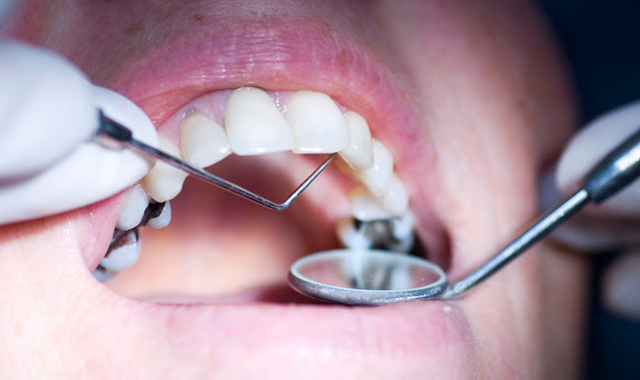7 ways poor infection control can endanger your practice
Poor infection control actions in the dental office can affect your reputation and bottom line.

It should go without saying that infection control is an important part of any dental practice. The health and welfare of your patients-and you and your team-is the most prominent issue, but there are other consequences that can stem from poor infection control practices. Here are seven repercussions that could occur as a result of poor infection control procedures.
Trending article: The 10 weirdest things patients have done in the dental practice
Click through the slides to learn more.


Harm
The first, most obvious impact is that someone could get injured. That could occur either through not following established protocols or a simple accident.
Read more: 6 overlooked areas in your office that can improve infection control
“Someone could be hurt. They could have an injury if they’re not using sharps safely, for instance, and having to go through post-exposure management,” says Kathy Eklund, RDH, director of occupational health and safety at The Forsyth Institute. “It is not only tied to noncompliance, but it can also be accidental injuries as well.”
Proper practices involve formalized procedures, consistent with the guidelines and recommendations from the Centers for Disease Control and Prevention (CDC) as well as following the directions and instructions of use for all products and devices.
“Not following the manufacturer’s directions and instructions for use, including reprocessing, can cause damage to devices such as handpieces. Other considerations include personnel wearing appropriate PPE and performing hand hygiene to prevent exposure to contamination,” Eklund says.



Reputation
Word gets around. Positive opinions help your practice, but, obviously, negative opinions can do quite a bit of damage. Worst of all, the practice may be blindsided by the occurrence.
“We all want to be known for doing the right thing,” says Karen Daw, an infection control consultant and former clinic health and safety director for The Ohio State University College of Dentistry. “In dentistry, this could mean providing quality care in a safe environment. If unsafe practices are occurring, some employees and patients may not feel comfortable bringing this to the attention of management directly.”
More from the author: Why the future looks bright for 3D printing
In this day and age, word travels quickly.
“They could very well share their impressions of your business with friends and family, sometimes via social media, an online review or even the nightly news,” Daw says. “And it’s happened. The dental office can be destroyed via the power of broadcast and social media. And if doing the right thing isn’t reason enough, think of how this impacts your bottom line. The last thing you want is to make a name in the industry for being an unsafe dental office to work in or visit. When the patients stop coming, there goes the revenue stream.”



License suspension or revocation
If bad word-of-mouth or a negative opinion doesn’t sound horrible enough, the state licensing board can add teeth to an infraction.
“Dental health care providers should know their state-specific licensing board regulations. If, in fact, those regulations require compliance with CDC guidelines, noncompliance may result in an investigation and regulatory actions for those licensees and facilities,” Eklund says.
Related article: 5 things you should be doing NOW to improve infection control
“The state dental board has regulations in place regarding infection prevention,” Daw adds. “If an office has to defend itself in front of a licensing board with regards to poor infection control, the outcome could include license suspension or worse, revocation.”
And it has happened.
“In 2014, a dentist voluntarily surrendered his license to his local dental board for ’practicing dentistry in an unsafe or unsanitary manner and by not following sterilization procedures,’” Daw says. “It doesn’t matter if you’re a pillar of the community, or how many volunteer hours you put in, poor infection control actions in the dental office can have a long-standing effect on your reputation and your livelihood.”



Setting a bad example
Like a virus, bad habits can be infectious. If someone in the practice is given the latitude to do the wrong thing-knowingly or unknowingly-that can spread to others.
Trending article: The top 10 dental memes of 2017
“Think about getting all staff members involved in the infection control program, because you want everyone to be compliant,” Eklund says. “If you have one provider who decides it’s too hot and they choose to not wear appropriate barrier attire, this could result in potential exposure to contamination as well as noncompliance with CDC recommendations and OSHA regulations. If that provider is only wearing a scrub top, that scrub top has to be removed by pulling over the head, creating a risk of contamination to the mucous membranes of the nose and eyes. Barrier attire has to be removed by unbuttoning, unfastening, or untying the front or the back. Another consideration is that the scrub top has short sleeves,and poses a greater risk of exposure to the arms.
“It is critical for personnel to work together and believe compliance is important, both for patient safety and personal safety,” she adds.



Perpetuating poor protocols past the practice
It is cliché, of course, but the phrase “old habits die hard” is an aphorism that makes perfect sense. Sometimes we get into bad habits that can stick with us for years to come. Unless we know better, those habits will remain, possibly being carried with us and infecting other professionals.
“One of my favorite phrases is, ’You don’t know what you don’t know,’” Daw says. “I consult with offices across the spectrum with regards to how solid of a safety program they have in place when I begin working with them. However, all of them still receive training to include a back-to-basics in infection control.”
More from the author: Achieving the proper torque and speed in a handpiece
Being reminded of those basics may seem like a step back to the first year of dental school, but that refresher might be just what is needed.
“Sometimes it’s because an individual was never educated properly to begin with. Other times, they just did not retain the information or developed an unsafe habit over time. And then, when those people move onto other dental practices, they potentially perpetuate the incorrect behavior with new team members, some who are themselves learning for the first time. It’s important to receive proper education and to receive ongoing education in infection control. By setting the right example ourselves, we help others to be safe, too.”



OSHA violations
Nothing strikes fear into the heart of an employer like the threat of an OSHA violation, and those in the health care field are not beyond OSHA’s reach.
“OSHA’s regulatory authority includes the ability to levy financial consequences for noncompliance,” Eklund says. “Last August they revised their penalties. A penalty could be as high as $12,600 per day per violation for not providing employees with appropriate personal protective equipment, for instance.”
Related article: 10 questions you need to ask about infection control
It isn’t just that employers can be subject to fines. They can be subject to staggeringly large fines.
“Few people realize how high an OSHA fine can climb,” Daw says. “I am aware of one dental office that received a substantial penalty by the Occupational Safety and Health Administration for ‘willful and serious violations.’”
OSHA violations encompass different areas, and not being current on those trainings or protocols can be expensive.
“In addition to not having a solid post-exposure protocol, in this instance the annual mandatory bloodborne pathogens training was not conducted with someone who answered questions about the training, and the exposure control plan was not completed or being updated annually as required under OSHA,” Daw adds. “An exposure control plan details the specifics of how we are going to keep the employees safe, and this includes infection prevention. This particular office received a proposed fine of $76,500. The current maximum penalty is up to $126,000 per violation. Yet another way failing to follow established safety guidelines can impact the bottom line.”



The bottom line
It is the practice’s pocketbook that takes the brunt of poor infection control. Be it a loss of business, a governmental fine, or a consequence from another source, if you are sloppy with infection control, you may end up paying in one way or another.
For example, Eklund notes that equipment can be damaged if manufacturer’s instructions are not followed.
Trending research: Study finds postmenopausal women with gum disease may have increased cancer risk
“If a staff member, for instance, is using a surface that has buttons, you should be putting barrier covers over those and changing the barriers between each patient,” Eklund illustrates. “But, let’s say a staff member feels better if they clean and disinfect it, even though it’s very difficult to disinfect between those buttons, and they’re using a disinfectant on it, and then they put the barrier on top of that before the disinfectant has dried, this practice could potentially begin a corrosion process on metal surfaces and have consequences of damaging the equipment.
“Another example: There are manufacturer’s maintenance and reprocessing instructions for reusable patient care items such as dental handpieces,” she continues. “If those instructions are not followed, even though the handpiece has been sterilized, it may not function properly, which may not be the result of sterilization, but rather improper maintenance and cleaning.”
The consequences of poor infection control can have negative repercussions on your practice, whether it be from causing harm to someone or affecting your practice’s bottom line.

Maximizing Value: The Hidden Benefits of Preventing Hospital-Acquired Pneumonia Through Oral Hygiene
September 10th 2024Originally posted on Infection Control Today. Hospital-acquired pneumonia (HAP) is a significant infection prevention concern, leading to high patient mortality, increased health care costs, and ICU usage. Oral hygiene is an effective preventive measure.